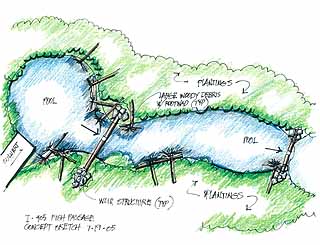
Surveys
DJC.COM
August 3, 2006
Fish to fly past the ‘Kirkland crawl’
AMEC Earth & Environmental

Donley
|
You’ve seen the project signs, witnessed the construction, possibly even cursed at the gridlock. The Kirkland Nickel project will widen Interstate 405 to eight lanes between Northeast 85th and 124th streets over the next two years, bringing relief to the twice-daily “Kirkland crawl.”
Not visible to motorists are traffic improvements being created for migrating cutthroat trout and other important fish species.
The right kind of project
The Washington State Department of Transportation’s design-build program was implemented in 2001 in recognition that design-build collaborations result in creative, sustainable solutions. The idea is that design-build, applied to the right kind of project with the right controls in place, gives the public a quality product in a shorter time.
With its potential to marry WSDOT’s design-build and ecological retrofit missions, officials felt the Kirkland Nickel was the right kind of project.

Image by Dick Myers/AMEC Earth & Environmental A series of cascading pools will help migrating fish navigate lower Forbes Creek to a new culvert below an expanded I-405. |
Kiewit Pacific was awarded the design-build contract in 2005 and Kiewit selected AMEC Earth & Environmental’s natural resources and permitting group to provide environmental compliance management.
A requirement of any WSDOT transportation infrastructure project is to look for opportunities to improve fish passage and aquatic habitat for fish species. For the Kirkland Nickel project, this would mean installing a 78-inch culvert to convey Forbes Creek beneath the highway, plus designing some means of safely negotiating a substantial change in elevation between the culvert outfall and the Forbes Creek bed.
Because the wider highway also would mean a longer fish passage, and a fish ladder or similar structure would be problematic to maintain, WSDOT asked the design-build team to explore fish- and budget-friendly alternatives. It was at this point that the creative solution part of design-build kicked in.
Fish like it
Mark Pedersen, AMEC’s veteran fisheries biologist, was first to spot the opportunity — an existing ephemeral drainage flowing north and adjacent to the highway that entered Forbes Creek, not far from the old culvert outfall. It inspired the idea of creating 250 feet of natural streambed adjacent to the highway, which would allow a much shorter replacement culvert.
Additional benefits of creating a more natural stream would include enhanced surface water drainage and improved downstream water quality, as well as a naturalistic habitat attractive to fish and wildlife. “Fish would rather swim in a natural environment than through a dark pipe,” Pedersen said when he presented the concept to the design-build team. “Fish like this.”
The design-build team liked it, too. So did WSDOT and the state Department of Fish and Wildlife.
It was apparent that the proposed fish passage improvement would support the long-term vision of the I-405 corridor master plan by allowing a future additional lane to be built with no additional reconstruction to the channel. But over the ensuing months, Pedersen’s original concept would undergo some changes in order to accommodate the jobsite’s construction constraints.
AMEC’s ecological restoration team designed a series of naturalistic cascading pools to accommodate the 12-foot elevation change between the new culvert’s outfall and the confluence with lower Forbes Creek. The pools had to be carefully configured to fit in the available span and still rise gradually enough to accord with Fish and Wildlife fish passage design guidelines.
Stream hydraulics were carefully modeled to ensure that instream flows would not impair fish passage, even during the 100-year flood event projected for full build out in the sub-basin, and that natural woody debris was correctly sized and anchored. With these challenges addressed, culvert construction began in mid-July, with streambed restoration scheduled to take place this month through year-end.
Water quality and stream health will be monitored by the design-builder for the first year following construction and by WSDOT for the next nine years. But we’ll know whether the fish passage improvements are a hit with their intended audience long before the Kirkland Nickel project is completed in 2007.
According to WSDOT: “Once these problem culverts are corrected, the benefits to fish habitat are real and immediate. In many cases, fish have been observed upstream of improved culverts within weeks of restoring access.”
Leslie Donley is a marketing coordinator and cat herder with more than 17 years of professional experience. She has worked for AMEC Earth & Environmental in Kirkland since 2002.
Other Stories:
- Mechanical engineers hop aboard the green bandwagon
- States keep their authority to regulate dams
- UW’s environmental strategy goes from grass roots to daily integration
- New rules for ‘innocent landowners’
- Washington banks on wetland mitigation
- Navigating our water right application process
- Tapping into a sea of power
- Orcas: the next killer environmental issue?
- Minimize data handling to reduce errors
- Solvent spill? Know your cleanup options
- Getting the creosote out of Puget Sound
- Green Factor would change urban landscape design
- Spokane does brownfields on a grand scale
- Plan ahead for the new stormwater permit
- Local environment benefits from oil spill
- Conservation program saves money, landfill space
- Education centers show how to tread lightly on the environment
Copyright ©2009 Seattle Daily Journal and DJC.COM.
Comments? Questions? Contact us.